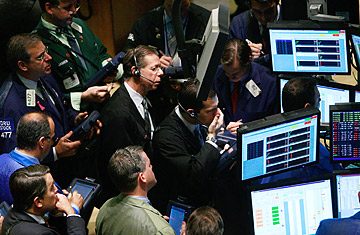
Traders work on the floor after the morning bell at the New York Stock Exchange on Nov. 20
Until a late-day rally on Friday, sparked by word that President-elect Obama would name Timothy Geithner as his new Treasury Secretary, last week was another brutal one for the stock market, with the S&P 500 stock index hitting an 11-year low. From trading floors to kitchen tables, people are anxiously asking, What's next? Historically, the markets rally as one calendar year turns into the next, but could there really be reason to hope for a year-end rally at a time when the only precedents that seem to apply are the worst bear markets on record? "Mid-December to the end of January is known as the only free lunch on Wall Street," says Sam Stovall, chief investment strategist at Standard & Poor's Equity Research. "This year could be different."
What's ahead for stocks? Trying to predict short-term market moves, of course, is one of the quickest ways to look like an idiot. And yet there are clues to be mined. (See pictures of the Top 10 scared traders.)
Right now, the companies in the S&P 500 are trading at an average price-to-forward-earnings (P/E) ratio of 8.4. That means investors are willing to pay $8.40 for every dollar that analysts expect companies to earn in 2009. Because that ratio historically falls in the mid- to high teens, the current market seems cheap by comparison, meaning stocks could be poised to rise.
However, S&P senior index analyst Howard Silverblatt cautions, "You have to look at those companies and see if they will truly make those earnings." If the denominator of the equation falls short, then the P/E ratio doesn't look so hot after all. And there is reason to think projected earnings might be overstated. An ongoing survey of stock analysts by Thomson Reuters projected as of Nov. 21 that next year's earnings growth of S&P 500 companies would be 11.7%. Three weeks earlier, that projection was 14.5%.
Yet even with more bad news on earnings, stocks worldwide still look cheap, according to an analysis headed by Robert Buckland, a global equity strategist at Citigroup. Even assuming corporate profitability falls 50% all told (so far it's down only about 10% from last year's peak), P/E ratios will still be in line with their 40-year average. "There's a major space for earnings to fall," says Buckland. "What we're saying is, a lot of that fall is already in the price."
Of course, that doesn't mean the market won't keep falling, getting even cheaper. For the global market, as measured by the MSCI World Index, to hit the valuation it did in the 1981 recession, stock prices would need to fall an additional 40%. (See the Top 10 Dow Jones drops.)
That sort of analysis, however, hardly accounts for all the factors that move the markets. One of the main forces behind the mass sell-offs in October, for instance, was hedge funds being forced to sell their holdings as they deleveraged, scrambling to raise cash to pay investors who wanted their money back. Those sorts of mechanical forces will surely play a role in the market going forward.
The good news about hedge-fund selling is that many funds raised substantial cash in the past month and should be able to meet redemptions with money they have on hand — at least in the short term. But the mutual-fund industry — for which fleeing investors don't have to give a 45-day notice, as they do for most hedge funds — may be a different story. According to an analysis by TrimTabs Investment Research, in the last bear market, at the time of the bursting tech bubble, 4.3% of dollars in U.S. stock funds were withdrawn. So far in this cycle, which is inarguably more severe, only 3.5% of such assets have fled. "To me, this says there's more mutual-fund selling to go," says TrimTabs president and COO Conrad Gann.
For the market, that could pose a double whammy. As mutual funds have been forced to sell long-held positions to meet redemptions this year, they have generated capital gains — which must be passed along to investors. We might therefore also see a round of year-end selling of mutual-fund shares by investors looking to offset gains and avoid paying taxes by locking in losses. "Tax-loss selling is a very powerful force," says Joe Battipaglia, market strategist for the private client group at Stifel Nicolaus. "The market is down 50% from a year ago — those are sizable losses."
There are, of course, a host of other issues that might swing the market one way or another, from the fates of Citigroup and the auto-industry bailout to the Federal Reserve's mid-December meeting, when another cut in interests may be in the offing. Add it all up and the short-term view is — surprise — more uncertainty. "Sometimes we have year-end rallies, and we definitely could use one. We could all use a break from this bear market," says Ed Yardeni, president of Yardeni Research. "But just because we need it doesn't mean we're going to get it."
